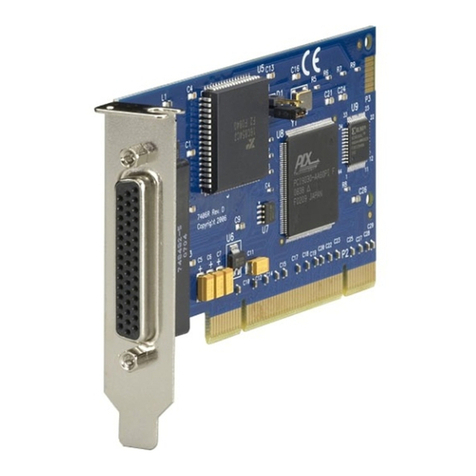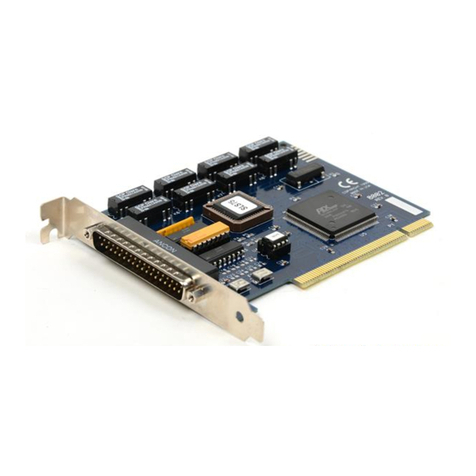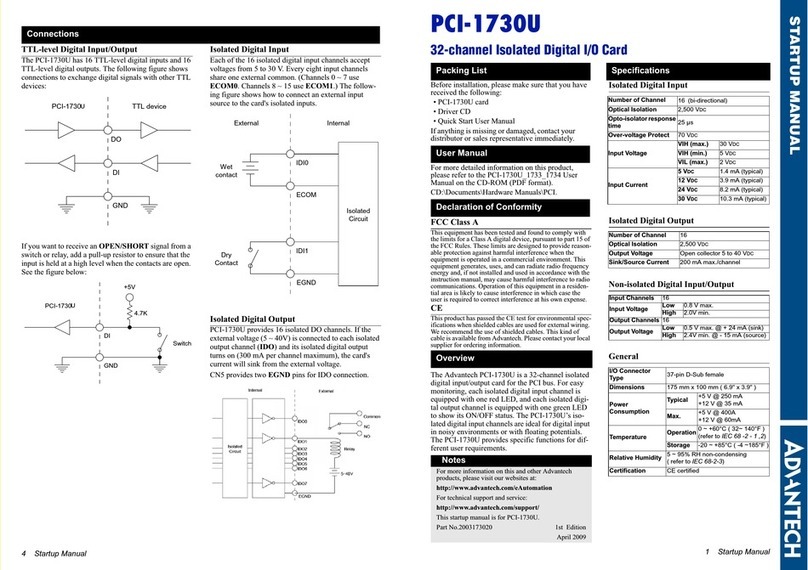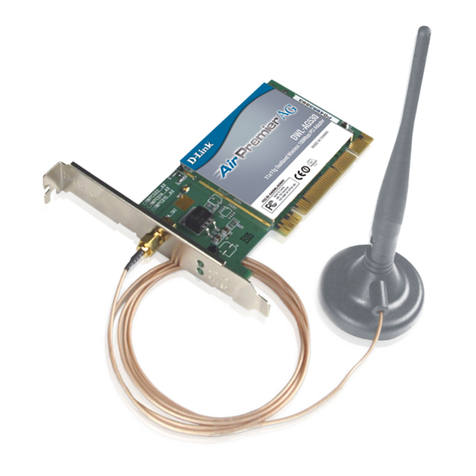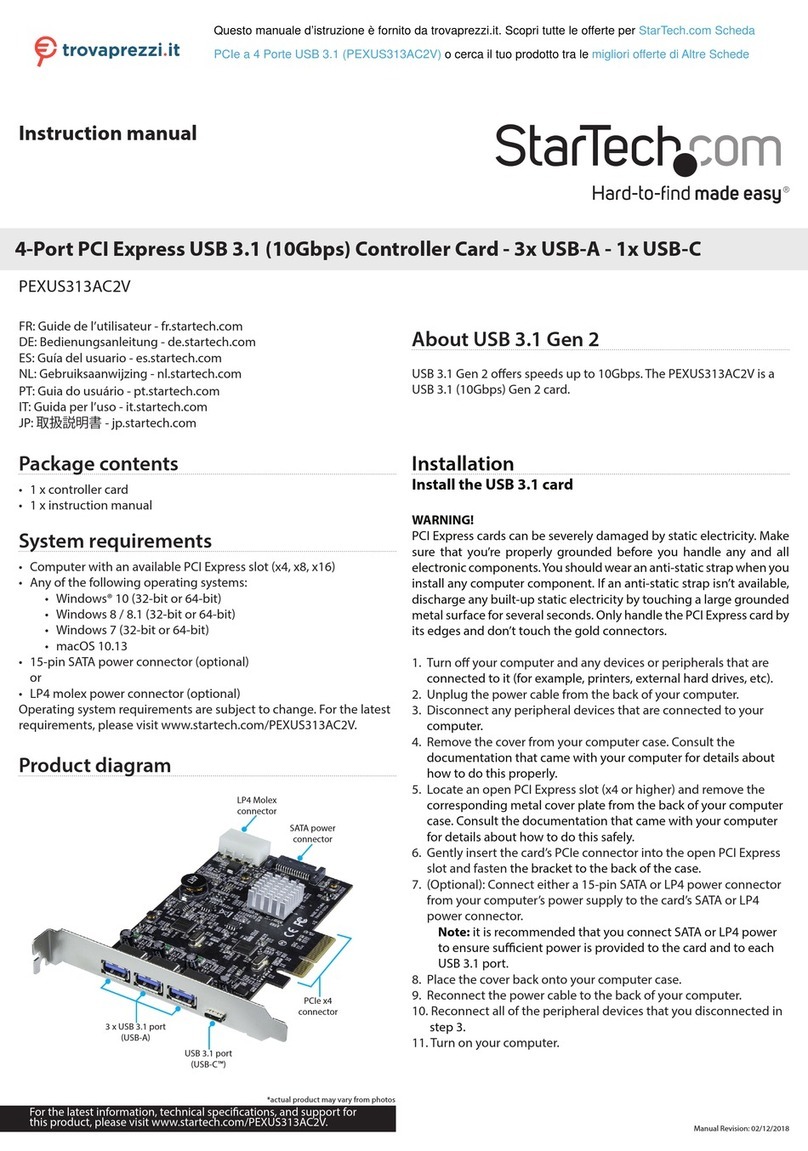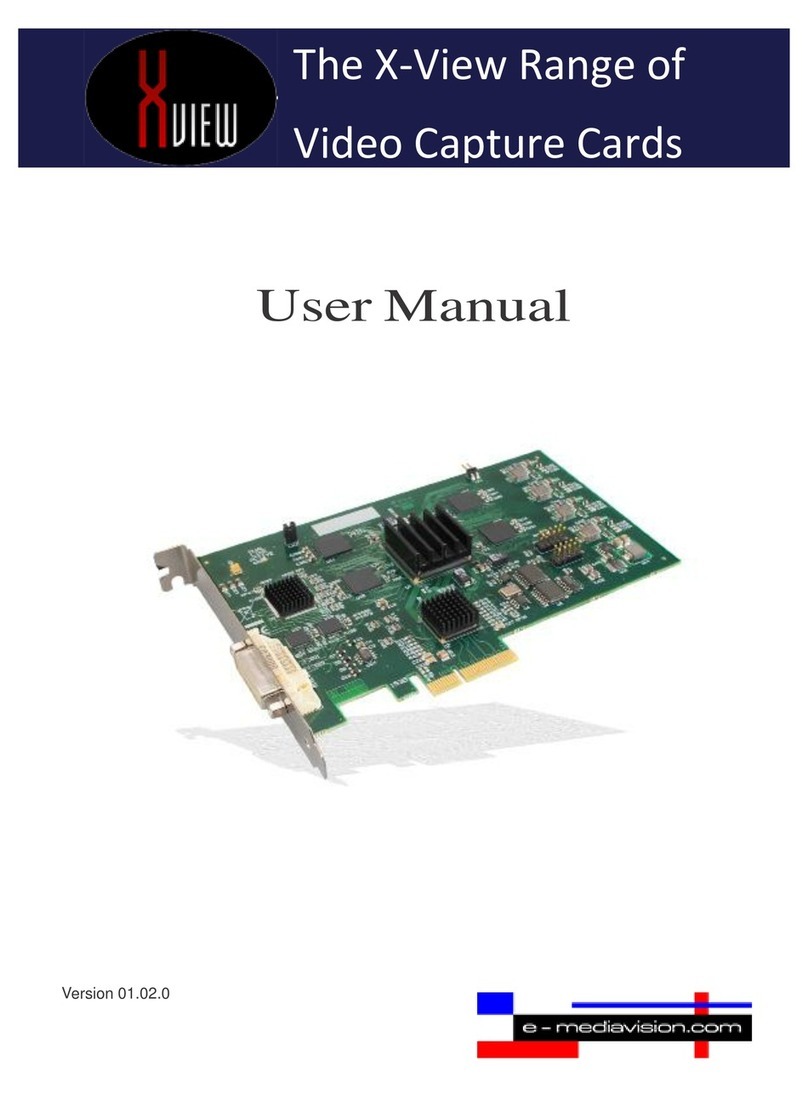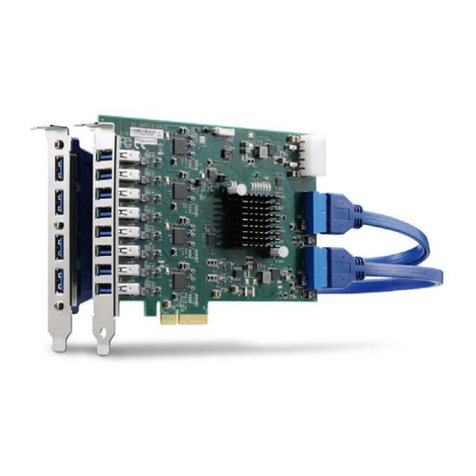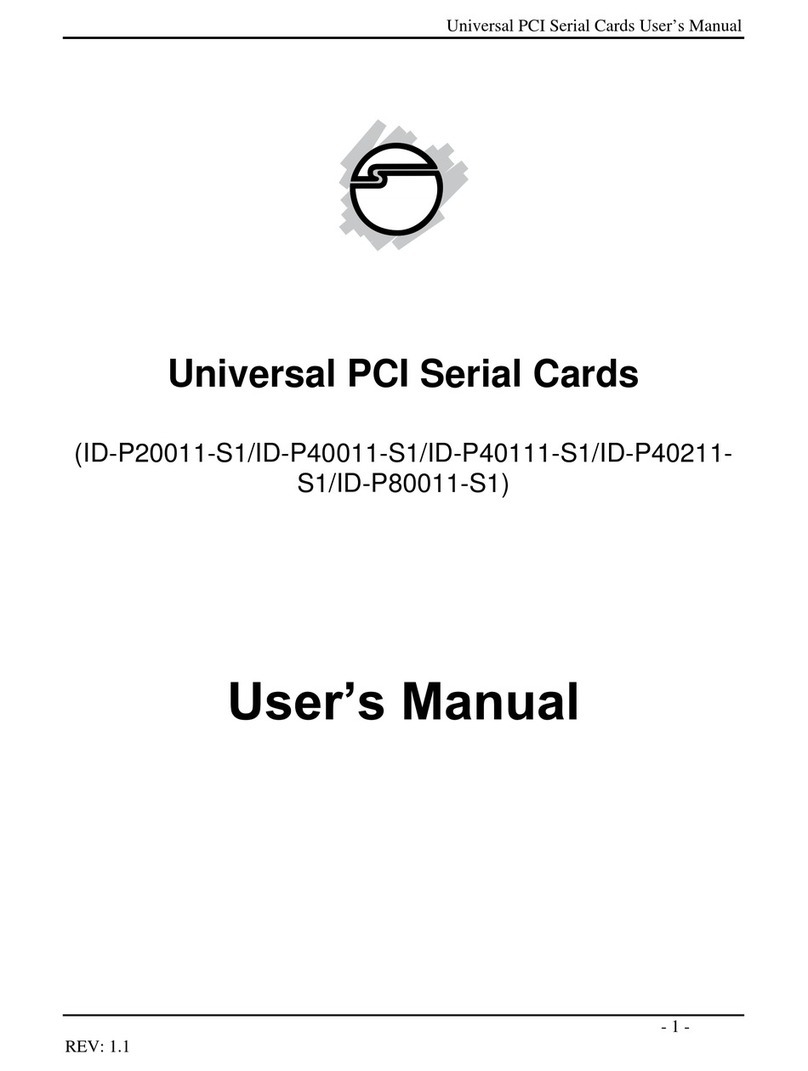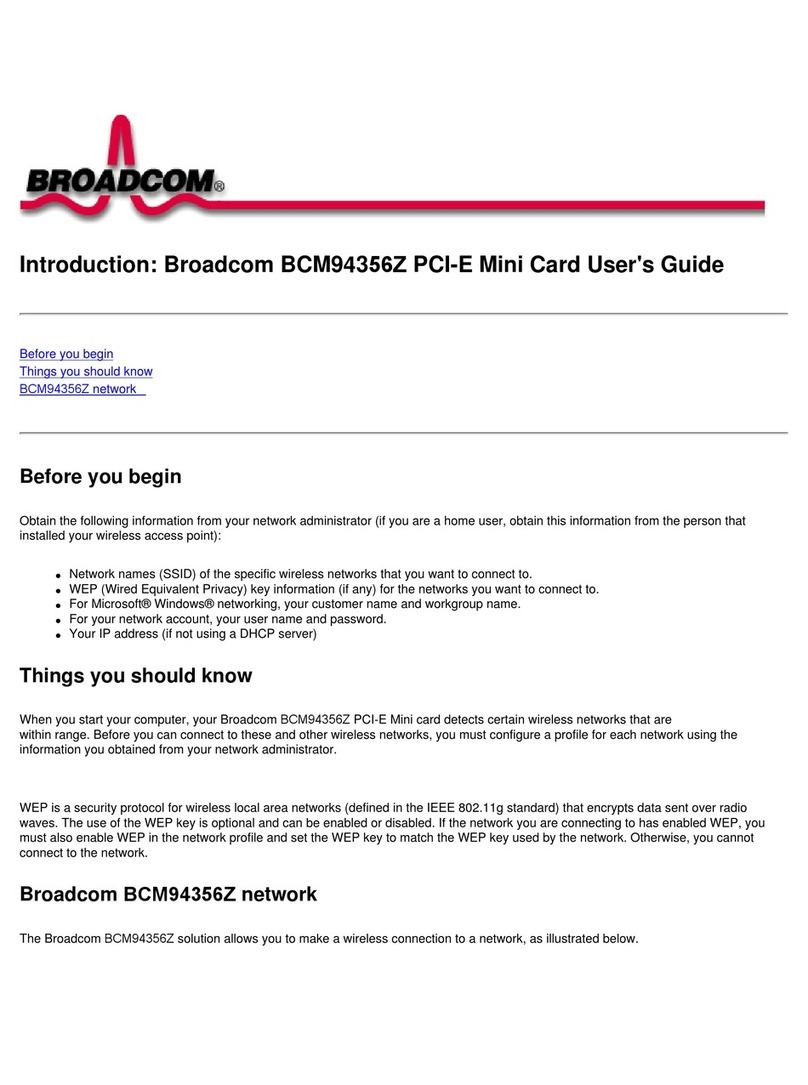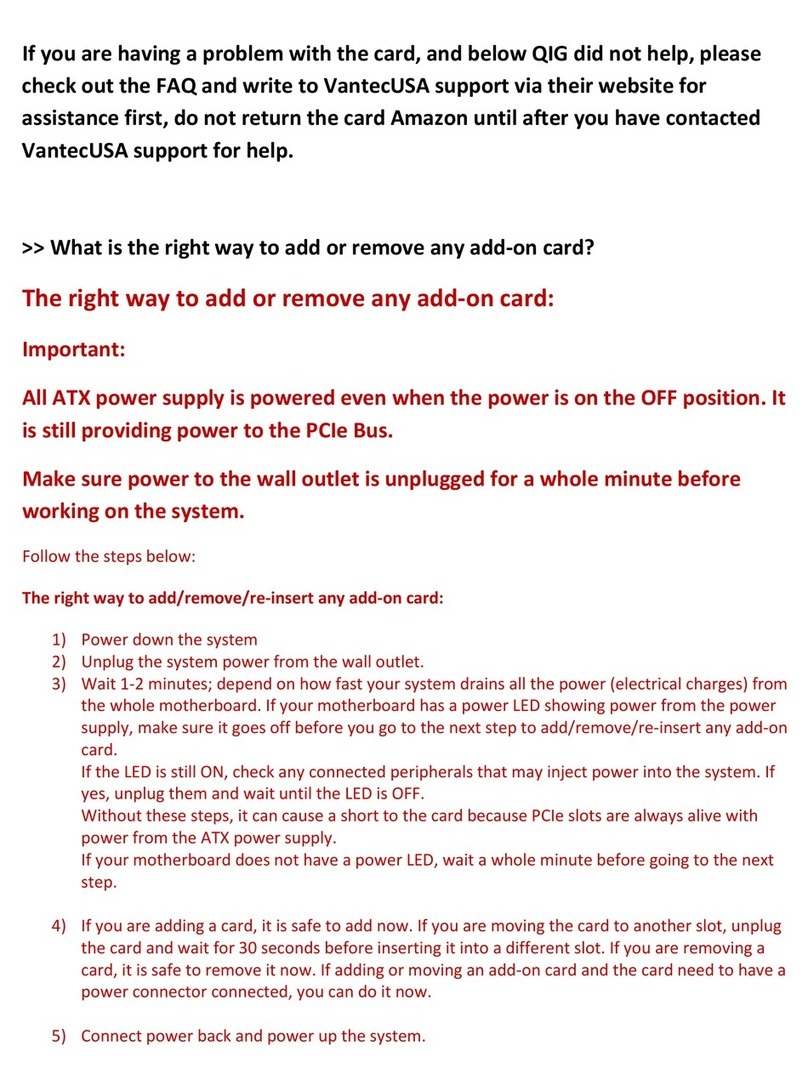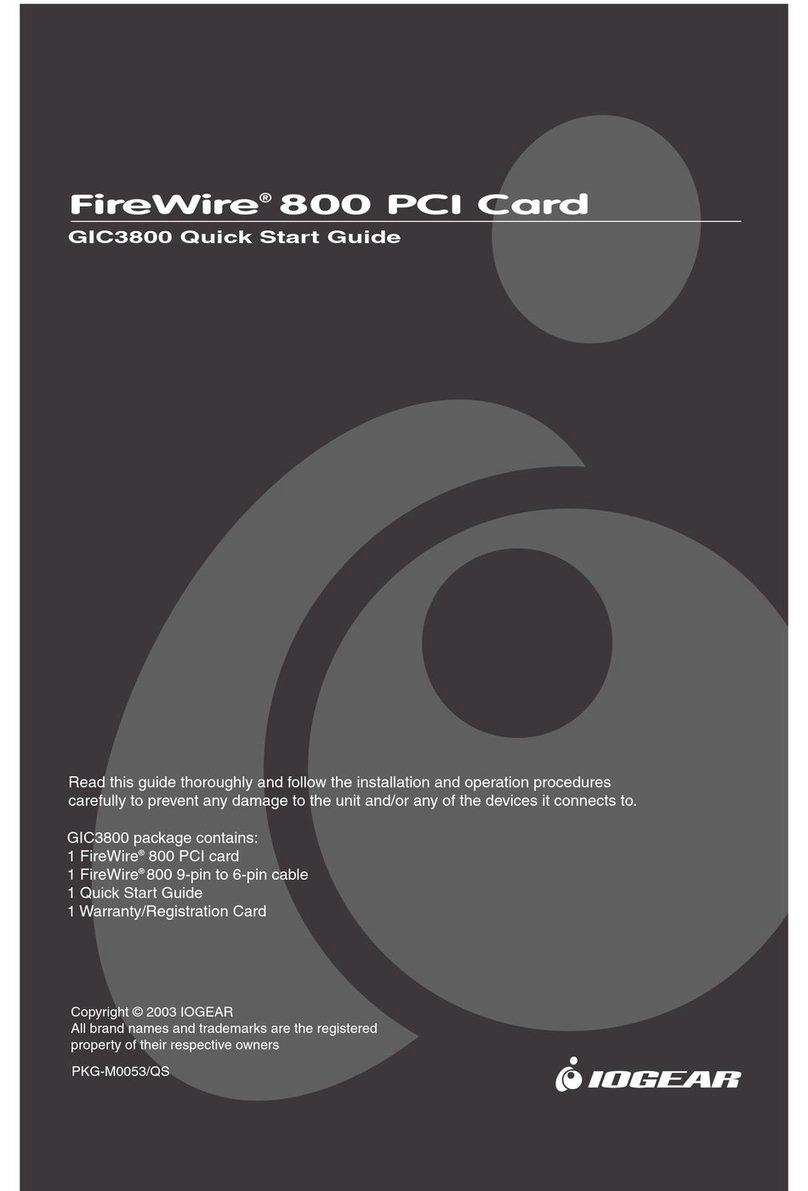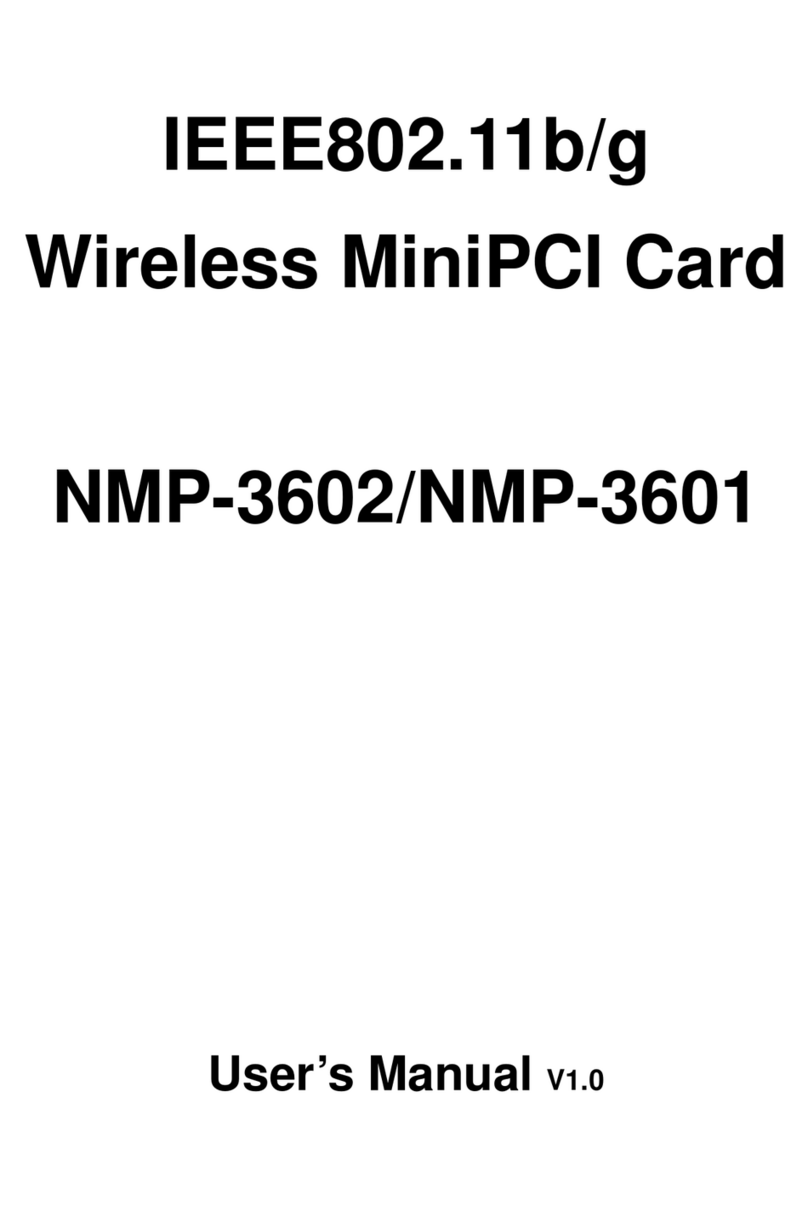Black Box IC970C User manual

MAY 2002
IC970C
RS-232 Single-Port PCI Card
CUSTOMER SUPPORT INFORMATION
Order toll-free in the U.S.: Call 877-877-BBOX (outside U.S. call 724-746-5500)
FREE technical support 24 hours a day, 7 days a week: Call 724-746-5500 or fax 724-746-0746
Mailing address: Black Box Corporation, 1000 Park Drive, Lawrence, PA 15055-1018

1
FCC AND IC RFI STATEMENTS
FEDERAL COMMUNICATIONS COMMISSION
and INDUSTRY CANADA
RADIO FREQUENCY INTERFERENCE STATEMENTS
Class B Digital Device. This equipment has been tested
and found to comply with the limits for a Class B
computing device pursuant to Part 15 of the FCC Rules.
These limits are designed to provide reasonable
protection against harmful interference in a residential
installation. However, there is no guarantee that
interference will not occur in a particular installation.
This equipment generates, uses, and can radiate radio
frequency energy, and, if not installed and used in
accordance with the instructions, may cause harmful
interference to radio communications. If this
equipment does cause harmful interference to radio or
telephone reception, which can be determined by
turning the equipment off and on, the user is
encouraged to try to correct the interference by one of
the following measures:
• Reorient or relocate the receiving antenna.
• Increase the separation between the equipment
and receiver.

2
RS-232 SINGLE-PORT PCI CARD
• Connect the equipment into an outlet on a circuit
different from that to which the receiver is
connected.
• Consult an experienced radio/TV technician for
help.
CAUTION
Changes or modifications not expressly approved by the
party responsible for compliance could void the user’s
authority to operate the equipment.
To meet FCC requirements, shielded cables and power
cords are required to connect this device to a personal
computer or other Class B certified device.
This digital apparatus does not exceed the Class B limits for
radio noise emission from digital apparatus set out in the Radio
Interference Regulation of Industry Canada.
Le présent appareil numérique n’émet pas de bruits
radioélectriques dépassant les limites applicables aux appareils
numériques de classe B prescrites dans le Règlement sur le
brouillage radioélectrique publié par Industrie Canada.

3
EU DECLARATION OF CONFORMITY
EUROPEAN UNION DECLARATION OF CONFORMITY
This equipment complies with the requirements of the
European EMC Directive 89/336/EEC.

4
RS-232 SINGLE-PORT PCI CARD
NORMAS OFICIALES MEXICANAS (NOM)
ELECTRICAL SAFETY STATEMENT
INSTRUCCIONES DE SEGURIDAD
1. Todas las instrucciones de seguridad y operación deberán ser leídas antes
de que el aparato eléctrico sea operado.
2. Las instrucciones de seguridad y operación deberán ser guardadas para
referencia futura.
3. Todas las advertencias en el aparato eléctrico y en sus instrucciones de
operación deben ser respetadas.
4. Todas las instrucciones de operación y uso deben ser seguidas.
5. El aparato eléctrico no deberá ser usado cerca del agua—por ejemplo,
cerca de la tina de baño, lavabo, sótano mojado o cerca de una alberca,
etc..
6. El aparato eléctrico debe ser usado únicamente con carritos o pedestales
que sean recomendados por el fabricante.
7. El aparato eléctrico debe ser montado a la pared o al techo sólo como sea
recomendado por el fabricante.
8. Servicio—El usuario no debe intentar dar servicio al equipo eléctrico más
allá a lo descrito en las instrucciones de operación. Todo otro servicio
deberá ser referido a personal de servicio calificado.
9. El aparato eléctrico debe ser situado de tal manera que su posición no
interfiera su uso. La colocación del aparato eléctrico sobre una cama,
sofá, alfombra o superficie similar puede bloquea la ventilación, no se
debe colocar en libreros o gabinetes que impidan el flujo de aire por los
orificios de ventilación.

5
NOM STATEMENT
10. El equipo eléctrico deber ser situado fuera del alcance de fuentes de calor
como radiadores, registros de calor, estufas u otros aparatos (incluyendo
amplificadores) que producen calor.
11. El aparato eléctrico deberá ser connectado a una fuente de poder sólo del
tipo descrito en el instructivo de operación, o como se indique en el
aparato.
12. Precaución debe ser tomada de tal manera que la tierra fisica y la
polarización del equipo no sea eliminada.
13. Los cables de la fuente de poder deben ser guiados de tal manera que no
sean pisados ni pellizcados por objetos colocados sobre o contra ellos,
poniendo particular atención a los contactos y receptáculos donde salen
del aparato.
14. El equipo eléctrico debe ser limpiado únicamente de acuerdo a las
recomendaciones del fabricante.
15. En caso de existir, una antena externa deberá ser localizada lejos de las
lineas de energia.
16. El cable de corriente deberá ser desconectado del cuando el equipo no
sea usado por un largo periodo de tiempo.
17. Cuidado debe ser tomado de tal manera que objectos liquidos no sean
derramados sobre la cubierta u orificios de ventilación.
18. Servicio por personal calificado deberá ser provisto cuando:
A: El cable de poder o el contacto ha sido dañado; u
B: Objectos han caído o líquido ha sido derramado dentro del
aparato; o
C: El aparato ha sido expuesto a la lluvia; o
D: El aparato parece no operar normalmente o muestra un cambio en
su desempeño; o
E: El aparato ha sido tirado o su cubierta ha sido dañada.

6
RS-232 SINGLE-PORT PCI CARD
TRADEMARKS USED IN THIS MANUAL
IBM and PS/2 are registered trademarks of
International Business Machines Corporation.
Windows and Windows NT are either registered
trademarks or trademarks of Microsoft Corporation in
the United States and/or other countries.
Any other trademarks mentioned in this manual are
acknowledged to be the property of the trademark owners.

7
CONTENTS
Contents
Chapter Page
1. Specifications . . . . . . . . . . . . . . . . . . . . . . . . . . . . 9
2. Introduction . . . . . . . . . . . . . . . . . . . . . . . . . . . 10
2.1 Overview . . . . . . . . . . . . . . . . . . . . . . . . . . . 10
2.2 What the Package Includes . . . . . . . . . . . . 10
2.3 Technical Description . . . . . . . . . . . . . . . . 11
2.4 RS-232 DB25 Male DTE Connector
Pin Assignments . . . . . . . . . . . . . . . . . . . 11
3. Card Setup . . . . . . . . . . . . . . . . . . . . . . . . . . . . . 12
3.1 Address and IRQ Selection . . . . . . . . . . . . 12
3.2 Clock Modes. . . . . . . . . . . . . . . . . . . . . . . . 12
3.3 Baud Rates and Divisors for
D1 Mode . . . . . . . . . . . . . . . . . . . . . . . . . 13
4. Installation . . . . . . . . . . . . . . . . . . . . . . . . . . . . . 14
4.1 Operating System Installation. . . . . . . . . . 14
4.1.1 For Windows Users . . . . . . . . . . . . . 14
4.1.2 Other Operating Systems. . . . . . . . 14
4.2 System Installation . . . . . . . . . . . . . . . . . . . 14

8
RS-232 SINGLE-PORT PCI CARD
Contents (continued)
Chapter Page
Appendix A. Troubleshooting. . . . . . . . . . . . . . . . . 16
A.1 Tips . . . . . . . . . . . . . . . . . . . . . . . . . . . . . . . 16
A.2 Calling Black Box. . . . . . . . . . . . . . . . . . . . 17
A.3 Shipping and Packaging . . . . . . . . . . . . . . 18
Appendix B. Electrical Interface . . . . . . . . . . . . . . . 19
Appendix C. Asynchronous Communication. . . . . 20
Appendix D. Board Layout . . . . . . . . . . . . . . . . . . . 23

9
CHAPTER 1: Specifications
1. Specifications
UART: 16850
Connector: (1) DB25 male
Interface: RS-232
Temperature Tolerance: Operating: 32 to 122°F (0 to
50°C); Storage: -4 to +158°F (-20 to +70°C)
Relative Humidity: 10 to 90%, noncondensing
MTBF: Greater than 150,000 hours (calculated)
Power: +5 VDC, 480 mA
Size: 2.3"H x 4.9"W (5.8 x 12.5 cm), excluding
goldfingers; 2.6"H x 4.9"W (6.6 x 12.5 cm), including
goldfingers
Weight: 2.6 oz. (73.7 g)

10
RS-232 SINGLE-PORT PCI CARD
2. Introduction
2.1 Overview
The RS-232 Single-Port PCI Card is a PCI Bus serial I/O
adapter. It provides one RS-232 serial port that supports
data rates up to 460.8 kbps.
2.2 What the Package Includes
The PCI Card is shipped with the following items.
• (1) RS-232 Single-Port PCI Card.
• (1) Serial Utilities Software CD-ROM containing
drivers for Windows®3.1x/95/98/2000 and
Windows NT®, Advanced COM drivers, utilities,
INF files, help files, and this users’ manual in PDF
format.
If either item is missing or damaged, contact Black Box
at 724-746-5500.

11
CHAPTER 2: Introduction
2.3 Technical Description
The RS-232 Single-Port PCI Card provides a versatile
interface for any RS-232 device including modems,
printers, and plotters.
The Card uses the 16850 UART. This chip features
programmable baud rates, data format, interrupt
control, and industry-leading 128-byte FIFOs.
2.4 RS-232 DB25 Male DTE Connector Pin Assignments
Signal Name Pin # Mode
TD Transmit Data 2 Output
RTS Request To Send 4 Output
DTR Data Term Ready 20 Output
GND Ground 7 —
RD Receive Data 3 Input
DCD Data Carrier Detect 8 Input
DSR Data Set Ready 6 Input
CTS Clear To Send 5 Input
RI Ring Indicator 22 Input

12
RS-232 SINGLE-PORT PCI CARD
3. Card Setup
3.1 Address and IRQ Selection
The RS-232 Single-Port PCI Card is automatically
assigned resources by your motherboard BIOS. Only the
I/O address may be modified by you.
Adding or removing other hardware may change the
assignment of I/O addresses and IRQs.
3.2 Clock Modes
The RS-232 Single-Port PCI Card uses a unique clocking
option that allows you to select from divide by 4 and
divide by 1 clocking modes. These modes are selected at
Header J1. (See Appendix D for proper location.)
To select the baud rates commonly associated with
COM: ports (that is, 2400, 4800, 9600, 19.2, … 115.2
kbps), place the jumper in the divide by 4 mode
(silk-screen “D4”) position.
To select the maximum data rates up to 460.8 kbps,
place the jumper in the divide by 1 (silk-screen “D1”)
position. Please refer to Table 3-1 on the following page
for these additional data rates.

13
CHAPTER 3: Card Setup
3.3 Baud Rates and Divisors for D1 Mode
Table 3-1 shows some common data rates and the rates
you should choose if using the adapter in D1 mode.
Table 3-1. Data rates.
For this Data Rate Choose this Data Rate
1200 bps 300 bps
2400 bps 600 bps
4800 bps 1200 bps
9600 bps 2400 bps
19.2 kbps 4800 bps
57.6 kbps 14.4 kbps
115.2 kbps 28.8 kbps
230.4 kbps 57.6 kbps
460.8 kbps 115.2 kbps
If your communications package allows the use of baud
rate divisors, choose the appropriate divisor from the
following table:
Table 3-2. Baud rate divisors.
For this Data Rate Choose this Divisor
1200 bps 384
2400 bps 192
4800 bps 96
9600 bps 48
19.2 kbps 24
38.4 kbps 12
57.6 kbps 8
115.2 kbps 4
230.4 kbps 2
460.8 kbps 1

14
RS-232 SINGLE-PORT PCI CARD
4. Installation
4.1 Operating System Installation
4.1.1 F
OR
W
INDOWS
U
SERS
Start by choosing Install Software at the beginning of
the CD. Choose Asynchronous COM: Port Software,
SeaCOM.
4.1.2 O
THER
O
PERATING
S
YSTEMS
Refer to the appropriate section of the Serial Utilities
Software.
4.2 System Installation
The RS-232 Single-Port PCI Card can be installed in any
of the PCI expansion slots and contains several jumper
straps for each port that must be set for proper
operation.
1. Turn off PC power. Disconnect the power cord.
2. Remove the PC case cover.
3. Locate an available PCI slot and remove the blank
metal slot cover.

15
CHAPTER 4: Installation
4. Gently insert the PCI Card into the slot. Make sure
that the adapter is seated properly.
5. Replace the screw.
6. Replace the cover.
7. Connect the power cord.
Installation is complete.

16
RS-232 SINGLE-PORT PCI CARD
Appendix A. Troubleshooting
A.1 Tips
Using the supplied software and following these simple
steps can eliminate most common problems.
1. Identify all I/O adapters currently installed in
your system. This includes your on-board serial
ports, controller cards, sound cards, etc. Identify
the I/O addresses used by these adapters, as well
as the IRQ (if any).
2. Configure your PCI Card so that there is no
conflict with currently installed adapters. No two
adapters can occupy the same I/O address.
3. Make sure the PCI Card is using a unique IRQ.
While the PCI Card does allow the sharing of
IRQs, many other adapters (that is, SCSI adapters
and on-board serial ports) do not. The IRQ is
typically selected via an on-board header block.
Refer to Chapter 3 for help in choosing an I/O
address and IRQ.
4. Make sure the PCI Card is securely installed in a
motherboard slot.

17
APPENDIX A: Troubleshooting
5. When running DOS or Windows 3.x, refer to the
supplied software and this manual to verify that
the PCI Card is configured correctly. This software
contains an easy-to-use diagnostic program (SSD)
that will verify if a card is configured properly.
6. For Windows 95/98/Me/2000 and Windows NT,
the diagnostic tool “WinSSD” is installed in the
SeaCOM folder on the Start Menu during the
setup process. First find the ports using the Device
Manager, then use “WinSSD” to verify that the
ports are functional.
7. Always use the diagnostic software when
troubleshooting a problem. This will eliminate any
software issues.
If none of the above steps solved the problem, please
refer to Section A.2.
A.2 Calling Black Box
If you determine that your RS-232 Single-Port PCI Card
is malfunctioning, do not attempt to alter or repair the
unit. It contains no user-serviceable parts. Contact Black
Box at 724-746-5500.

18
RS-232 SINGLE-PORT PCI CARD
Before you do, make a record of the history of the
problem. We will be able to provide more efficient and
accurate assistance if you have a complete description,
including:
• the nature and duration of the problem.
• when the problem occurs.
• the components involved in the problem.
• any particular application that, when used,
appears to create the problem or make it worse.
A.3 Shipping and Packaging
If you need to transport or ship your RS-232 Single-Port
PCI Card:
• Package it carefully. We recommend that you use
the original container.
• If you are shipping the RS-232 Single-Port PCI
Card for repair, make sure you include everything
that came in the original package. Before you ship,
contact Black Box to get a Return Authorization
(RA) number.

19
APPENDIX B: Electrical Interface
Appendix B. Electrical Interface
Quite possibly the most widely used communication
standard is RS-232. This implementation has been
defined and revised several times and is often referred
to as RS-232 or EIA/TIA-232. The IBM®PC computer
defined the RS-232 port on a DB9 connector, and
subsequently the EIA/TIA approved this implement-
ation as the EIA/TIA-574 standard. This standard is
defined as the 9-Position Non-Synchronous Interface
between Data Terminal Equipment and Data Circuit-
Terminating Equipment Employing Serial Binary Data
Interchange. Both implementations are in widespread
use and will be referred to as RS-232 in this document.
RS-232 is capable of operating at data rates up to
20 kbps at distances less than 50 ft. The absolute maxi-
mum data rate may vary due to line conditions and cable
lengths. RS-232 is a single-ended or unbalanced
interface, meaning that a single electrical signal is
compared to a common signal (ground) to determine
binary logic states. The RS-232 and the EIA/TIA-574
specification define two types of interface circuits, DTE
and DCE. The RS-232 Single-Port PCI Card is a DTE
device.
Table of contents
Other Black Box PCI Card manuals

Black Box
Black Box IC906C User manual
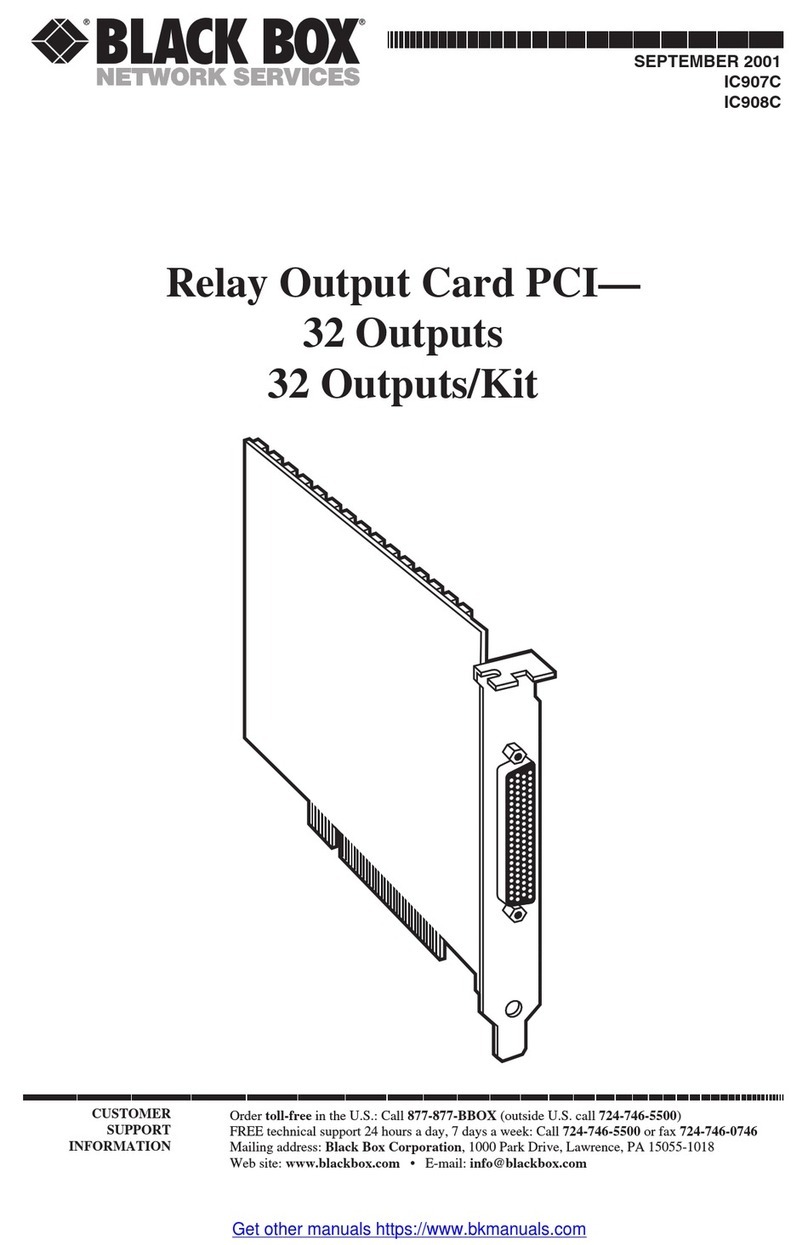
Black Box
Black Box IC907C User manual
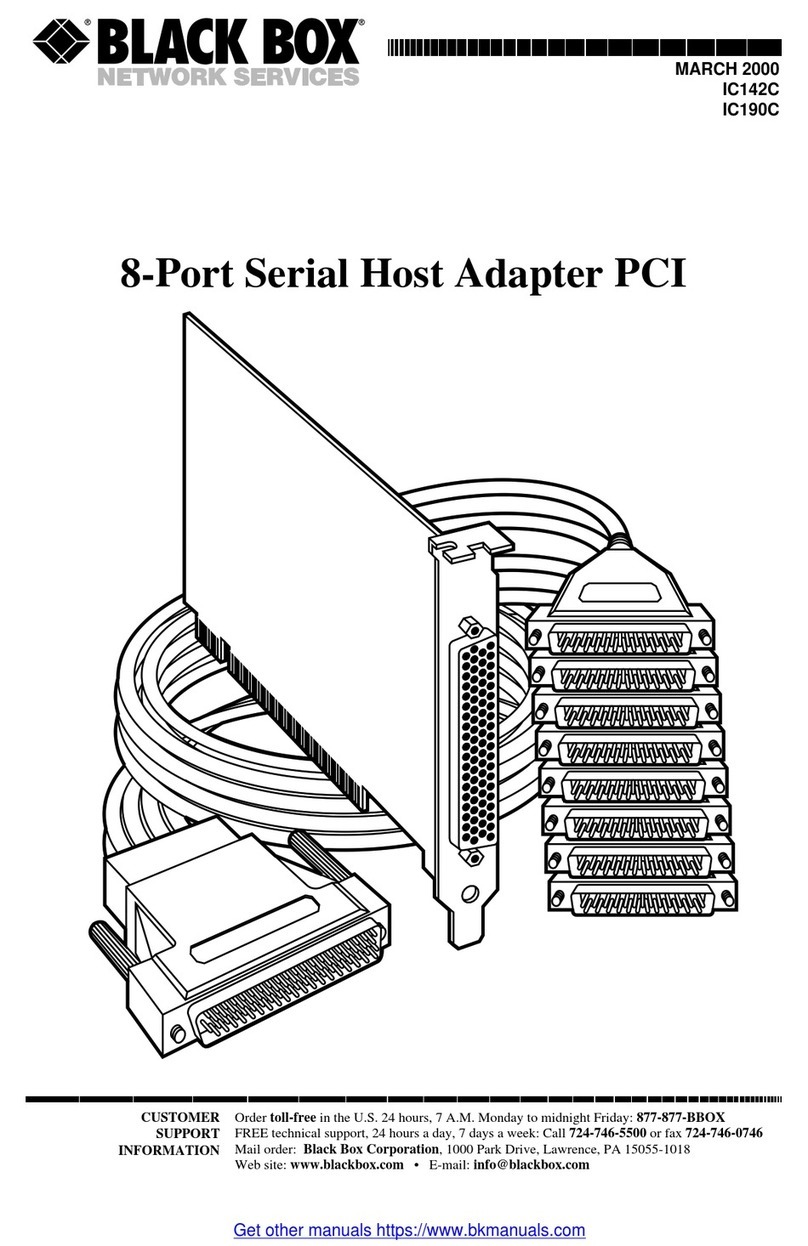
Black Box
Black Box IC142C User manual
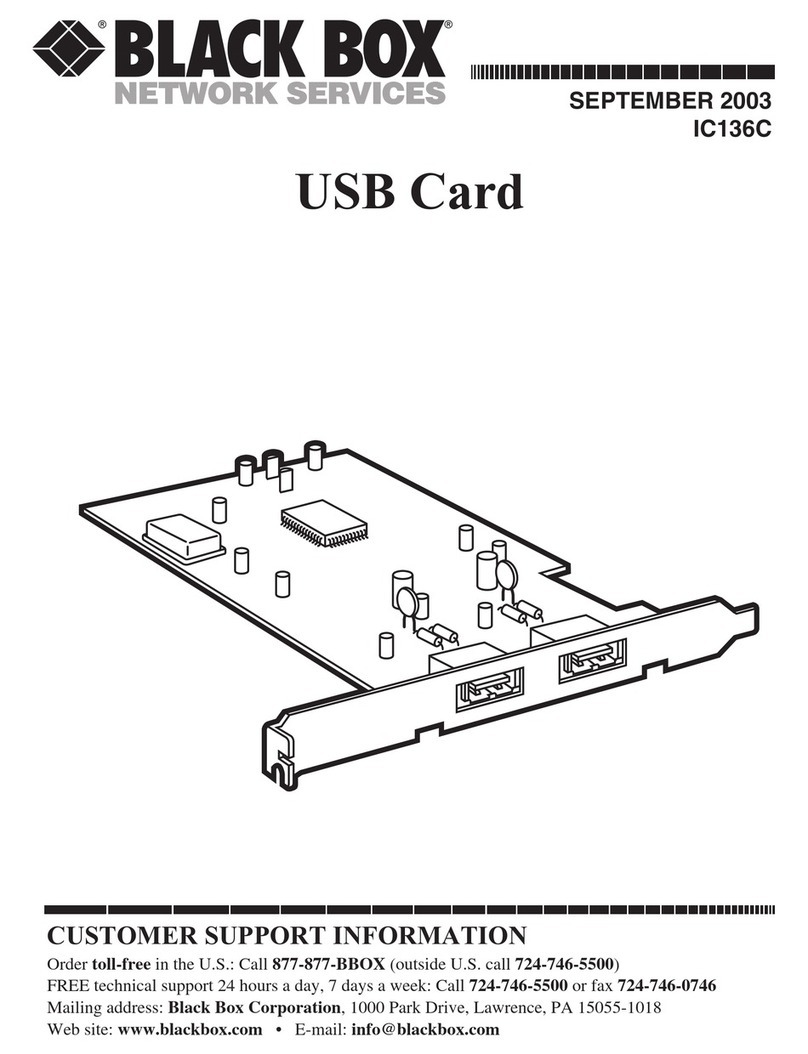
Black Box
Black Box IC136C User manual
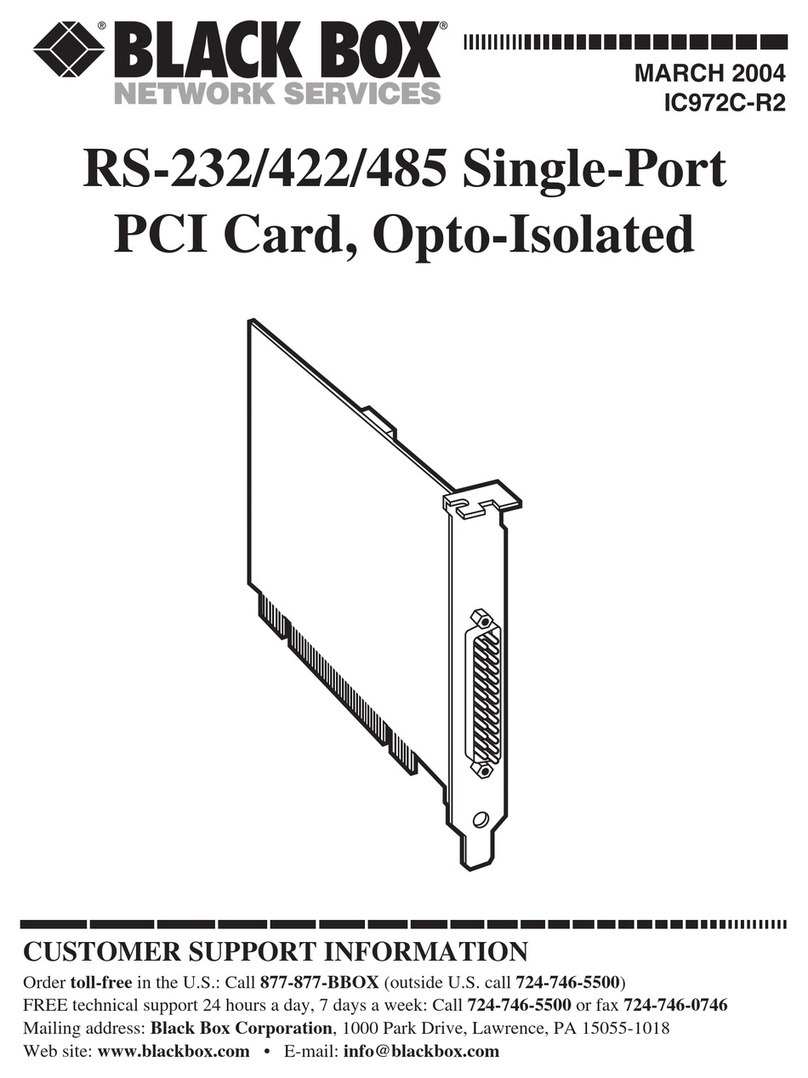
Black Box
Black Box USB Director RS-232 User manual

Black Box
Black Box IC126C User manual

Black Box
Black Box LH1390C-SC-R2 User manual

Black Box
Black Box IC142C User manual
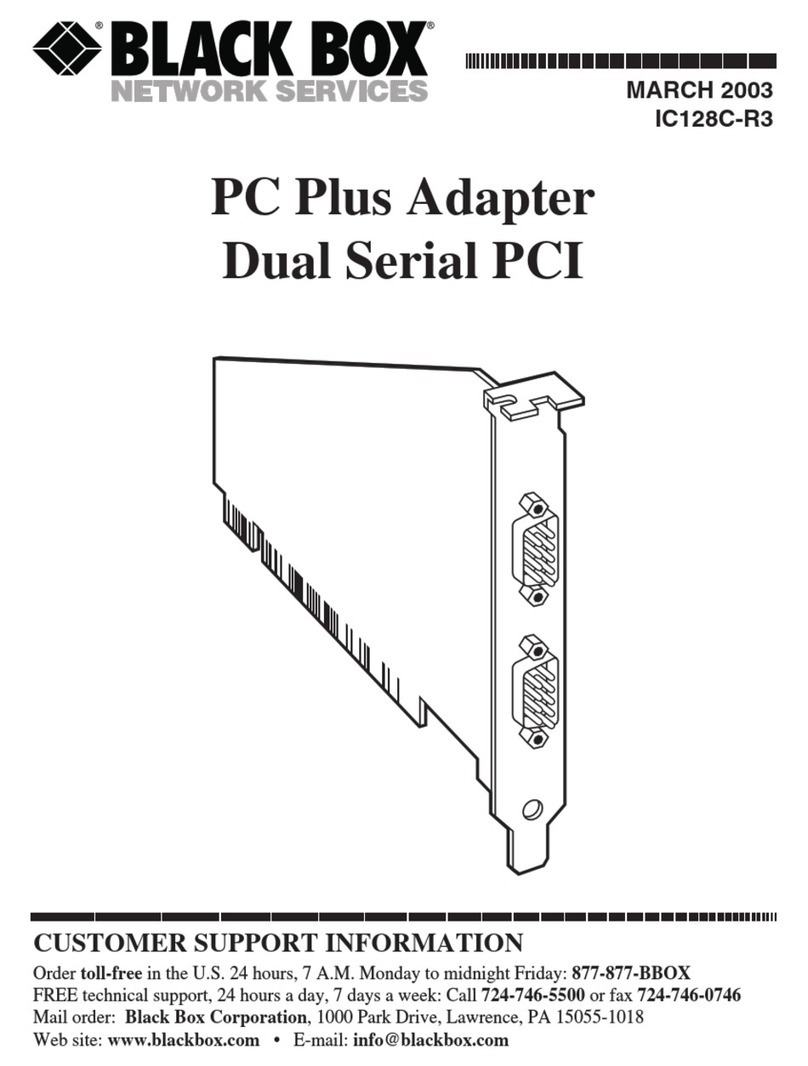
Black Box
Black Box IC128C-R3 User manual
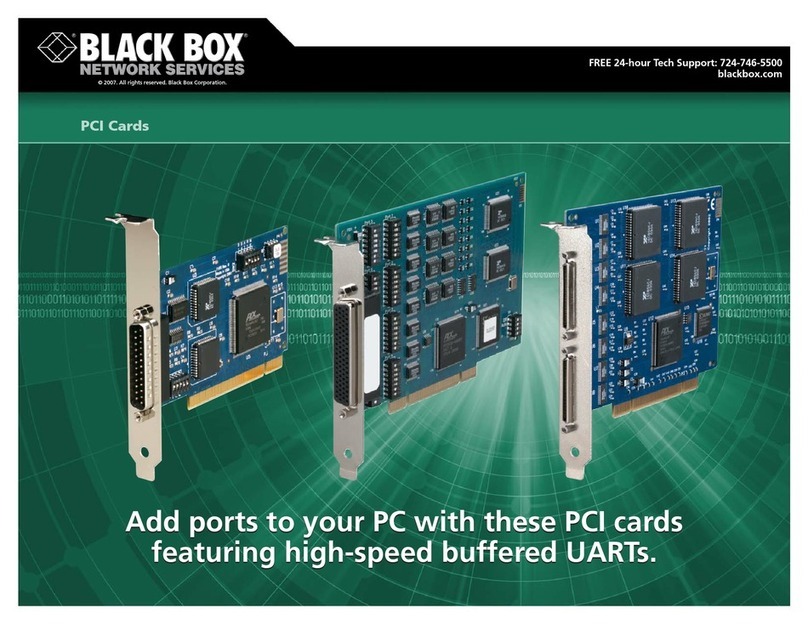
Black Box
Black Box IC142C User manual
Popular PCI Card manuals by other brands
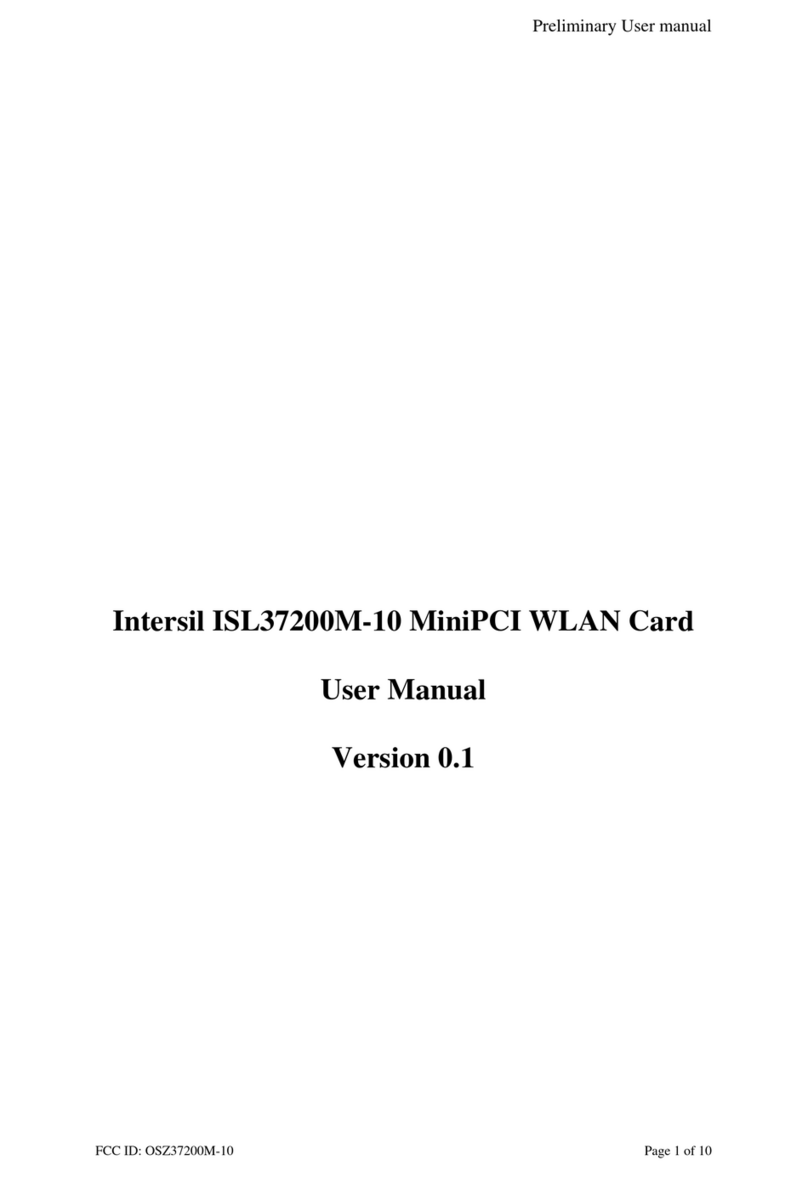
Intersil
Intersil ISL37200M-10 user manual
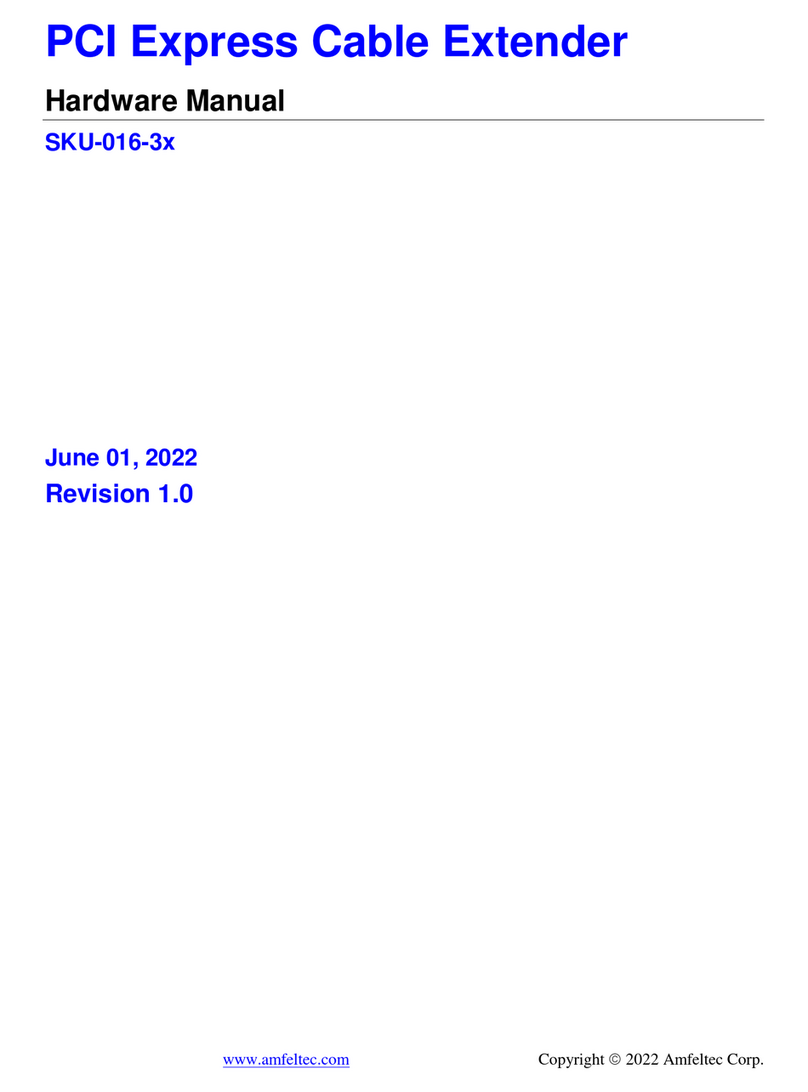
Amfeltec Corp.
Amfeltec Corp. SKU-016-3x Hardware manual
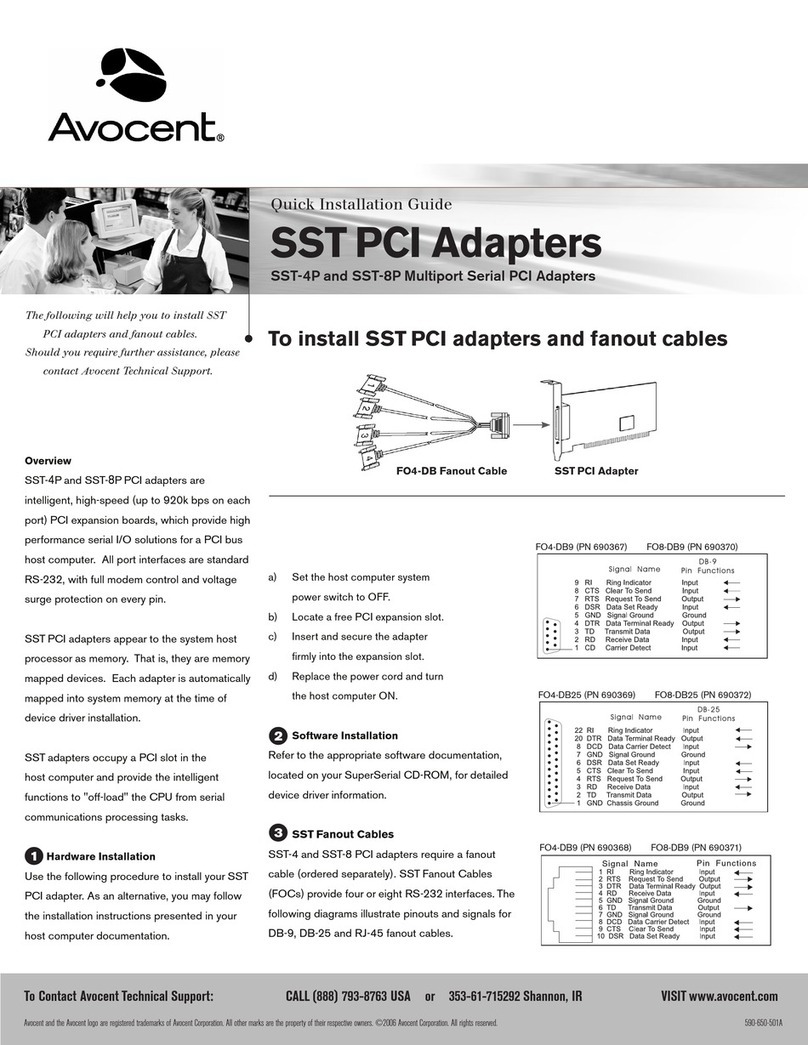
Avocent
Avocent Equinox Multiport SST-8P Quick installation guide
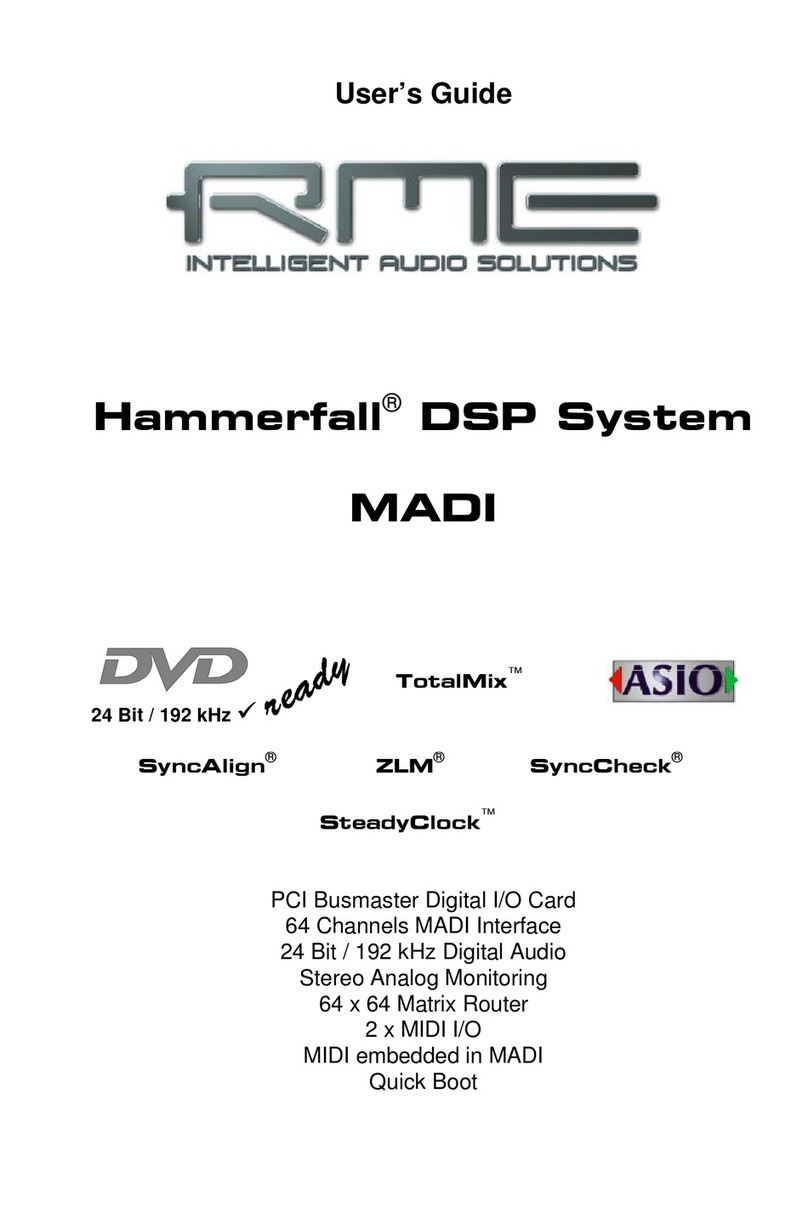
RME Audio
RME Audio Hammerfall DSP System MADI user guide

SMC Networks
SMC Networks SMCWPCI-N user guide
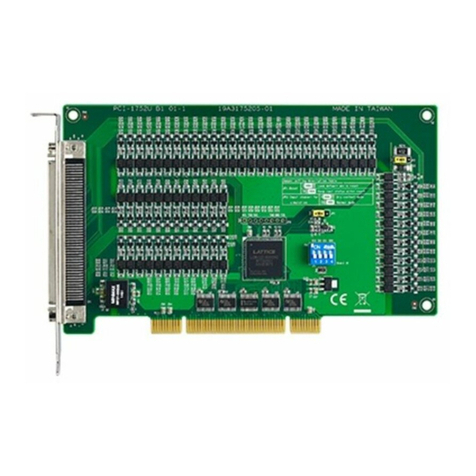
Advantech
Advantech PCI-1752USO user manual
